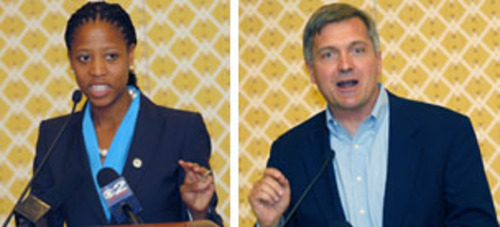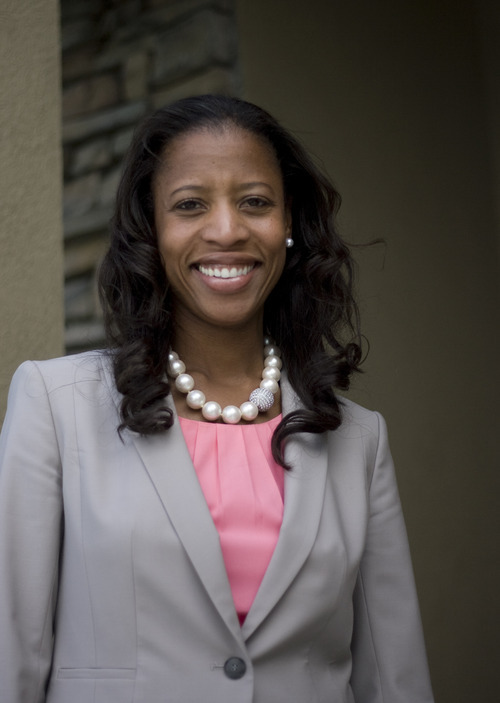This is an archived article that was published on sltrib.com in 2012, and information in the article may be outdated. It is provided only for personal research purposes and may not be reprinted.
A tsunami of political ads is headed for the Wasatch Front, and all television viewers will find it difficult to escape.
Whether you are watching the news in the morning or at night, a daytime talk show or the hottest evening drama, you're likely to get flooded with ads meant to influence the contest between Rep. Jim Matheson and Saratoga Springs Mayor Mia Love.
It all started this week with ads supporting Matheson paid for by the American Chemistry Council and the National Republican Congressional Committees gets in on the act Friday. And from then on the blitz of 30-second spots on Utah stations only intensifies up to Election Day.
More than $2.2 million in TV airtime has already been reserved to run nearly 7,700 individual spots that, if aired back to back, would stretch for more than 34 straight hours — not to mention drive the viewer mad.
Most remarkably, the candidates themselves haven't spent a nickel on TV airtime yet.
So far, only third-party groups have been staking their claim to broadcast, cable and satellite time, trying to influence the race. The $2.2 million spent so far breaks down almost evenly — with just above $1 million spent on each side. The Democrats have bought more spots, while the Republicans have paid more for ads when more viewers are watching.
Love is backed exclusively by the National Republican Congressional Committee at this point, while ads favoring Matheson will come from the Democratic Congressional Campaign Committee, American Chemistry Council, the House Majority PAC and Center Forward, which used to be called the Blue Dog Research Forum.
Such costly and continuous campaigns are new to the state, says Tom Love, president of Love Communications, a Salt Lake City-based advertising firm.
"That is a big, big number," he said. "I'm not aware of any [Utah] race where the combined spending has been that much money."
The one exception, he said, may have been in 1992, when Tom Love was selling ads for KTVX and Joe Cannon and Bob Bennett spent millions on a Republican Senate primary.
"Utah will see a barrage of political advertising this fall that we've never seen before," said Love, who is not related to Mia Love. "It's not just because of the 4th District, it will be governor, it will be Senator Hatch, it will be Salt Lake County mayor. It will be a whole bunch of races with a whole bunch of money, but it will be headlined by Jim and Mia."
Love Communications is working for Democrat Ben McAdams in the Salt Lake County mayor's race, but is not working on the 4th District duel.
—
Outside money • Matheson said he is not surprised by the flood of money and noted that outside groups spent heavily for and against him during his first run in 2000.
"In the world we're in after Citizens United, third-party groups are now more active than ever in communicating in election cycles," said Matheson, referring to the Supreme Court ruling that allows groups to spend unlimited amounts of largely unregulated money during elections.
Matheson said campaigns can still communicate their messages — despite all the noise from outside groups' ads.
"The concern is the misinformation that is put out by third-party groups and how you hold them accountable, and this is something we have to keep an eye on," he said. "It's going to be something different for most people in Utah from what they've seen before, and I hope everyone takes the time to understand who is communicating the message and who is responsible."
Utah Republican Party Chairman Thomas Wright expects plenty of money to pour into the contest from both sides.
"It's going to be insane," he said. "I think at the end there is a saturation point, and both candidates will reach that."
On balance, though, Wright believes the ad flood probably benefits Love more than it does Matheson, who has outspent his opponents in recent campaigns.
"Matheson has traditionally been able to run against opponents who are underfunded … and Mia isn't going to be underfunded, and that's an advantage to her," he said. "She can run a race on equal footing with him."
—
New rules • Earlier this year the Federal Communications Commission ruled that details of political ad campaigns must be placed online. Previously, these reports were available only at TV station offices.
The new access, with reports made available only in the past few days, makes it much easier to see how groups such as the NRCC plan to support their favorite candidate. However, cable and satellite providers do not have to disclose ad buys. KUTV also has experienced technical issues and ad buys were available only at the station.
The NRCC is starting its campaign on the eve of the Republican National Convention, which takes place the last week of August, and is spending anywhere from a few hundred dollars for spots in daytime shows to somewhere in the low thousands for prime-time hits.
The NRCC is spending $2,200 for one spot during KSL's coverage of the third day of the convention, when vice presidential candidate Paul Ryan speaks.
Cable ads, by contrast, are a bargain, partly because they reach fewer viewers. The DCCC reserved a whopping 3,050 ads on Comcast cable — divided across six viewing areas — for the bargain price of just more than $60,000.
All of the ad details are merely reservations of time, at this point, and the parties and PACs can decide to pull out of the race or pump more in, depending on how the dynamics unfold.









